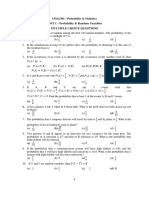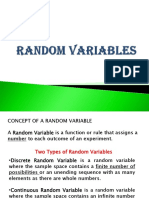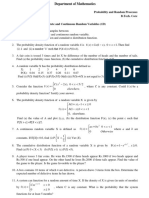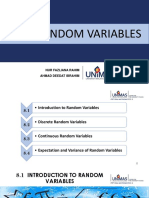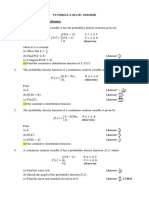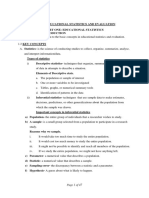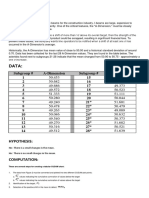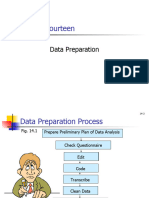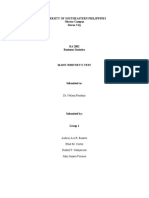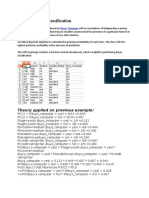UCCD 1143 Probability and Statistics for Computing
Tutorial 5
Continuous Random Variable
1. The random variable X has a probability density function
1
𝑓(𝑥) = {𝑟 , 2 ≤ 𝑥 ≤ 10,
0, 𝑜𝑡ℎ𝑒𝑟𝑤𝑖𝑠𝑒.
Find r.
2. The random variable X has a probability density function
𝑘(2𝑥 + 3) , − 1 ≤ 𝑥 ≤ 2,
𝑓(𝑥) = {
0, 𝑜𝑡ℎ𝑒𝑟𝑤𝑖𝑠𝑒.
Find k.
[Show your answer in fraction.]
3. The random variable X has a probability density function
ℎ(1 − 𝑥), 0 < 𝑥 < 1,
𝑓(𝑥) = {
0, 𝑜𝑡ℎ𝑒𝑟𝑤𝑖𝑠𝑒.
Find h.
[Show your answer in fraction.]
1
�UCCD 1143 Probability and Statistics for Computing
4. The random variable X has a probability density function given by
1
(4 − 3𝑥 2 ) , − 1 ≤ 𝑥 ≤ 1,
7
𝑓(𝑥) = {1 , 1 < 𝑥 ≤ 2,
7
0, 𝑜𝑡ℎ𝑒𝑟𝑤𝑖𝑠𝑒.
Show your answer in fraction.
a) Sketch the probability density function.
b) Find 𝑃(𝑋 ≤ 0).
c) Find 𝑃(0.5 ≤ 𝑋 ≤ 1.5).
5. Consider the density function
𝑓(𝑥) = { 𝑘√𝑥, 0 < 𝑥 < 1,
0, 𝑒𝑙𝑠𝑒𝑤ℎ𝑒𝑟𝑒,
where k is a constant number.
a) Evaluate k.
[Show your answer in fraction.]
b) Find F(x) and use it to evaluate 𝑃(0.3 < 𝑋 < 0.6).
[Show your answer in 4 decimal places.]
6. A continuous random variable X has a probability density function
𝑎𝑥 2 , − 2 < 𝑥 < 2,
𝑓(𝑥) = {
0, 𝑜𝑡ℎ𝑒𝑟𝑤𝑖𝑠𝑒.
where a is a constant number.
a) Find the value of a.
[Show your answer in fraction.]
b) If 𝑃(|𝑋| < 𝑚) = 0.5, find m.
[Show your answer in 3 decimal places.]
2
�UCCD 1143 Probability and Statistics for Computing
7. A continuous random variable X has a probability density function defined by
1
(2𝑥 + 1), 0 ≤ 𝑥 ≤ 1,
5
𝑓(𝑥) = 1
(4 − 𝑥)2 , 1 ≤ 𝑥 ≤ 4,
15
{ 0, 𝑜𝑡ℎ𝑒𝑟𝑤𝑖𝑠𝑒.
[Show your answer in fraction.]
a) 1
Show that the continuous distribution function, F(𝑥) for 0 ≤ 𝑥 ≤ 1 is 5 𝑥(𝑥 + 1).
b) Find the value of 𝑃(𝑋 ≤ 1).
c) 17
Find the value of x for which 𝑃(𝑋 ≥ 𝑥) = 20.
8. The probability density function f of a continuous random variable X is defined as follows:
𝑎𝑥 + 𝑏, 0 ≤ 𝑥 < 4,
𝑓(𝑥) = {
𝑏𝑥 + 𝑎, 4 ≤ 𝑥 < 5.
[Show your answer in fraction.]
a) 23
If 𝑃(2 ≤ 𝑋 < 4) = 51, find the values of a and b.
b) Find 𝑃(𝑋 ≤ 3).
9. The total number of hours, measured in units of 100 hours, that a family runs a vacuum
cleaner over a period of one year is a continuous random variable 𝑋 that has the density
function
𝑥, 0 < 𝑥 < 1,
𝑓(𝑥) = {2 − 𝑥, 1 ≤ 𝑥 < 2,
0, 𝑒𝑙𝑠𝑤ℎ𝑒𝑟𝑒.
Find the probability that over a period of one year, a family runs their vacuum cleaner
[Show your answer in 3 decimal places.]
a) less than 120 hours.
b) between 50 and 100 hours.
3
�UCCD 1143 Probability and Statistics for Computing
10. The joint density of X and Y is 𝑓(𝑥, 𝑦) = 𝑦 2 (𝑥𝑦 3 + 1) on the rectangle where 0 ≤ 𝑥 ≤ 𝑘
and 0 ≤ 𝑦 ≤ 1. Find
[Show your answer in fraction.]
a) the value of k.
b) 𝑃(𝑋 ≤ 𝑌).
11. Random variables X and Y have joint PDF
6𝑒 −(2𝑥+3𝑦) , 𝑥 ≥ 0, 𝑦 ≥ 0,
𝑓𝑋,𝑌 (𝑥, 𝑦) = {
0, 𝑜𝑡ℎ𝑒𝑟𝑤𝑖𝑠𝑒.
[Show your answer in 4 decimal places.]
a) Find 𝑃(𝑋 ≥ 𝑌).
b) Find 𝑃(𝑋 + 𝑌 ≤ 1).
c) Find 𝑃(min(𝑋, 𝑌) ≥ 1).
d) Find 𝑃(max(𝑋, 𝑌) ≤ 1).








